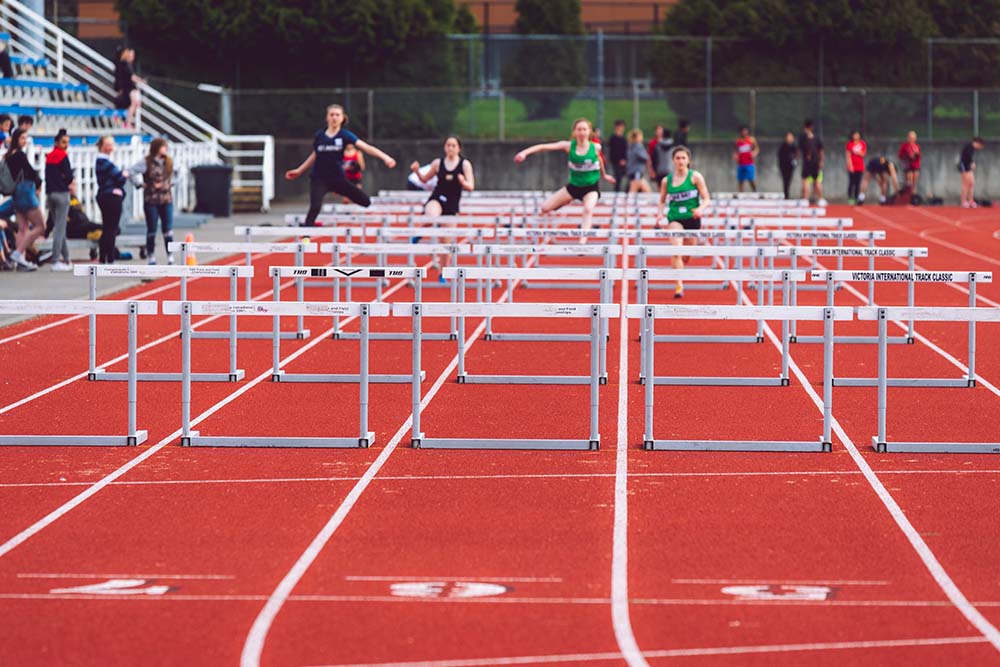Sprint Training: The Secret To Younger Muscles – Part 1

Fiona Callender, Research Assistant, University of Toronto
Sprint Training: The Secret To Younger Muscles – Part 1
It has long been accepted that as we age we will all face an inevitable loss in muscle function and size. But it may be possible to slow down this process through exercise that targets specific muscle fibers – fast twitch fibers.
Our muscles are composed of both “fast twitch” and “slow twitch” muscle fibers. Fast twitch muscle fibers tend to be bigger, produce more force, contract more rapidly and fatigue much more quickly. Slow twitch muscles, on the other hand, are smaller, but they can work at a lower force for a much longer amount of time without fatigue. Everyone has a combination of both slow and fast twitch muscles and as we age the ratio of the space they occupy in our muscles changes. This process begins as early as age 30 in some people (Lexell et al., 1988 ;Ortel, 1986).
Sprinting Muscles
In 2006, Korhonen and colleagues, in their study entitled “Aging, muscle fiber type, and contractile function in sprint-trained athletes”, examined the muscles of highly trained male sprinters between the ages of 18 and 84 to determine the influence of age and long-term sprint training on their musculature. Their findings may change the way you choose to exercise!
The aging process in humans is characterized by a loss of muscle mass, loss of force generating capabilities and decreased speed of muscle contractions. There also appears to be a decrease in the ratio of fast twitch to slow twitch fibers as a person ages. Could consistent sprint training delay these age-associated declines in our muscles? What this study found may surprise you. Korhonen and colleagues found that as a sprinter ages, the size of their fast twitch fibers appears to decrease but the area of slow twitch fibers stays very much the same. Younger sprinters have fast twitch fibers that are bigger than their slow ones, but as a person
Younger sprinters have fast twitch fibers that are bigger than their slow ones, but as a person ages their individual fast twitch fibers become smaller than their slow twitch. This creates a decrease in the overall ratio of area occupied by fast twitch to slow twitch muscle. Interestingly, in sprint-trained people across all ages, the authors found that 53-60% of their individual muscle fibers were fast twitch fibers, meaning there was no difference in the number of fast twitch fibers! So although the fast twitch fibers get smaller, the actual number of fast twitch fibers seemed to be maintained.
 As You Age
As You Age
The speed at which slow type muscle fibers contract was also slower in older sprinters but the speed of fast twitch fibers was found to be no different than the younger group. When the authors compared their results to those in a previous study with middle aged (40 years old) and older (70 years old) men (Häkkinen et al., 2001; Häkkinen et al., 1998), the 70 year old sprinters maintained their muscle size more than 50% greater than age-matched men; including their fast twitch fibers! What is even more outstanding is that the oldest sprinters had muscle sizes equivalent to untrained 40 year old men.
Although the men in this study did have a long history of training which is obviously not realistic for most people, it does shine a pretty convincing light on sprint training as an important element in training as we age. Older sprinters maintained their strength and size of muscle fibers to a greater extent than untrained individuals. Unfortunately, this study was conducted with an entirely male population and because of hormonal changes associated with menopause, it is possible that this process may differ slightly in women.
It would be interesting to see future research on female sprint athletes across this same age range. Although we can’t conclusively state that the changes would be identical, it does seem likely that this form of training would be of great benefit to both men and women throughout their lifespan. The authors of this study suggest that adding sprint training into a physical training plan could minimize aging in the neuromuscular system!
References
Korhonen, M.T., Cristea, A., Alén, M., Häkkinen, K., Sipilä, S., Mero, A., Viitasalo, J.T., Larsson, L., Suominen, H. (2006). Aging, muscle fiber type, and contractile function in sprint-trained athletes. J Appl Physiol 101:906-917.
Lexell J, Taylor CC, and Sjöström M. (1988). What is the cause of the ageing atrophy? Total number, size and proportion of different fiber types studied in whole vastus lateralis muscle from 15- to 83-year-old men. J Neurol Sci 84: 275–294.
Oertel G. (1986). Changes in human skeletal muscles due to ageing. Histological and histochemical observations on autopsy material. Acta Neuropathol (Berl) 69: 309–313.
Häkkinen K, Kraemer WJ, Newton RU, and Alen M. (2001). Changes in electromyographic activity, muscle fibre and force production characteristics during heavy resistance/power strength training in middle-aged and older men and women. Acta Physiol Scand 171: 51–62.
Häkkinen K, Newton RU, Gordon SE, McCormick M, Volek JS, Nindl BC, Gotshalk LA, Campbell WW, Evans WJ, Häkkinen A, Humphries BJ, and Kraemer WJ. (1998). Changes in muscle morphology, electromyographic activity, and force production characteristics during progressive strength training in young and older men. J Gerontol A Biol Sci Med Sci 53: B415–B423.You Might Like:















